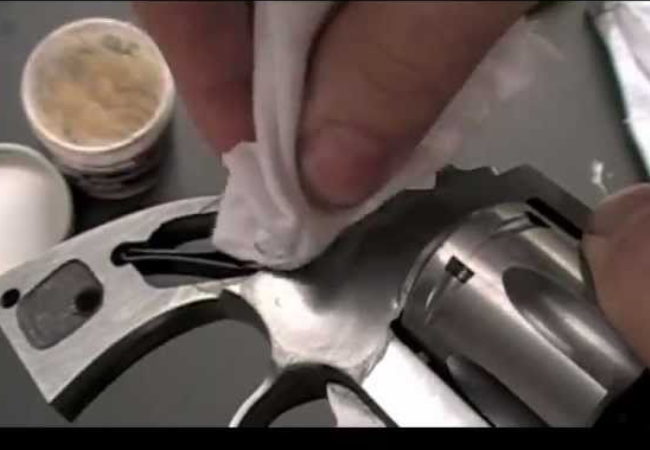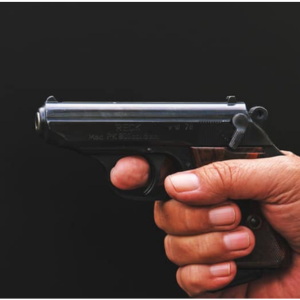Stainless steel, while being a popular material choice for many firearms due to its durability and resistance to corrosion, can sometimes be too reflective or shiny for certain applications.

For those looking to reduce glare or achieve a more tactical or subdued look, blackening the steel is a viable option.
Here, we explore various methods to blacken stainless steel guns.
Benefits of Blackening Stainless Steel Guns
- Reduced Glare: Stainless steel can be quite reflective. Blackening it helps reduce glare, which could be advantageous in tactical situations where you wouldn’t want to reveal your position.
- Aesthetics: Many gun enthusiasts prefer the sleek, matte finish of a blackened stainless steel gun. It offers a modern and tactical look that many find appealing.
- Protection: Although stainless steel is resistant to corrosion, blackening can provide an additional layer of protection against the elements.
- Reducing Visibility: In certain hunting or tactical scenarios, a shiny firearm could be easily spotted. A blackened gun blends in more seamlessly with the surroundings.
- Improved Resale Value: Customized guns can often fetch a higher price on the market. A professional blackening job could potentially increase the resale value of your firearm.

Chemical Blackening
- Commercial Kits: Several commercial blackening kits are available on the market. These kits contain a specific solution designed to blacken stainless steel. Always follow the manufacturer’s instructions when using these products.
- Surface Preparation: Before blackening, ensure the gun is completely disassembled, and any oil, grease, or dirt is removed. This can be achieved by using a degreaser or a solvent.
- Safety: First When working with chemicals, always wear gloves, protective eyewear, and work in a well-ventilated area. Some of the chemicals used can produce fumes that are harmful if inhaled.
- Application: Immerse the parts to be blackened in the solution or apply it using a brush. The duration will depend on the product’s instructions.
- Neutralizing and Oiling: After blackening, the parts will need to be rinsed and neutralized. Finish off by applying a thin layer of oil to protect the newly blackened surface.
Heat or Thermal Blackening
- Equipment: Heat blackening requires a propane or acetylene torch. The process involves heating the stainless steel to produce an oxide layer.
- Surface Preparation; As with chemical blackening, ensure the gun is clean and free of any grease or oil.
- Heating Process: Using the torch, evenly heat the stainless steel parts until they begin to darken. The exact color can vary based on the temperature and duration.
- Cooling and Protection: Allow the parts to cool naturally. Once cooled, apply a protective layer of oil or wax to prevent corrosion.
- Practice: Making Perfect Heat blackening takes practice to master. It’s advisable to test on scrap stainless steel first.
Electrochemical Blackening
- The Science: Electrochemical blackening is a process where an electric current is passed through a solution, resulting in a black oxide layer on the stainless steel.
- Equipment: You’ll need a power supply, electrodes, and a suitable electrolyte solution. Kits are available for those new to the process.
- Procedure: Submerge the gun parts in the solution and connect them to the negative electrode. The positive electrode should also be submerged in the solution but not in contact with the gun parts. Turn on the power supply and let the process run.
- Duration: The time required varies based on the specific setup and desired results.
- Post-Treatment: Like the other methods, rinse, neutralize, and oil the parts after blackening.
Things to Consider
- Skill Level: Each blackening method requires a certain skill level. Some may find chemical blackening simpler than the precision required for heat blackening.
- Equipment: Costs Consider the cost of equipment and solutions, especially if you’re blackening a single gun.
- Maintenance: Blackened guns require regular maintenance. The blackened layer can wear off or get scratched over time, necessitating touch-ups.
- Legal Considerations: Before altering your firearm, ensure that it’s legal in your jurisdiction. Some places have regulations against modifying firearms.
- Professional Services: If you’re unsure about blackening your gun yourself, consider hiring a professional. They’ll have the expertise and equipment to achieve the desired results.

Final Considerations
- Skill Assessment: Each method has its learning curve. While some may find chemical methods straightforward, others might favor the tangible nature of heat blackening.
- Budgeting: Consider the initial costs of acquiring the necessary equipment and materials, especially if blackening just one or a few guns.
- Maintenance: Regular upkeep is vital. Over time, the blackened surface might show signs of wear or minor scratches, which would need touch-ups.
- Regulations: Always ensure that modifying the appearance of your firearm is permissible under the laws of your jurisdiction.
- Professional Assistance: If the DIY route seems daunting, there’s always the option to enlist the services of professionals who specialize in firearm blackening.
Conclusion
Blackening stainless steel guns merges functionality with aesthetics, offering both tactical advantages and a refined appearance.
Whether one opts for chemical, thermal, or electrochemical methods, the key lies in understanding the nuances of each technique, emphasizing meticulous preparation, and adhering to safety protocols.
Moreover, while the DIY route provides a sense of accomplishment, professionals are always on standby for those who prefer expert hands.
Ultimately, no matter the chosen path, the process of blackening not only enhances a firearm’s visual appeal but also amplifies its protective features, longevity, and overall value.
As with any craft, knowledge, patience, and practice are the pillars to achieving the desired outcome.
FAQs:
What will blacken stainless steel?
There are multiple methods to blacken stainless steel, including chemical blackening using commercial kits, heat or thermal blackening using a torch, and electrochemical blackening that involves passing an electric current through a solution to form a dark oxide layer on the steel. Each method has its advantages and nuances, so the best approach often depends on the specific application and desired outcome.
Can you make stainless steel into black stainless steel?
Yes, you can make stainless steel into black stainless steel using the methods mentioned above. The process involves creating a darkened or black oxide layer on the surface of the stainless steel to achieve a black appearance. The blackened finish not only provides an aesthetic appeal but can also offer additional protection against corrosion and reduce glare or reflectivity.
Can stainless steel guns be blued?
Bluing is a traditional method used to protect steel firearms from rusting. The process involves creating a controlled oxide layer on the surface. While bluing is most commonly associated with carbon steel, it is possible to blue stainless steel guns. However, the process for stainless steel is a bit different and can be more challenging than for carbon steel, as stainless steel’s corrosion-resistant properties make it less receptive to the bluing process. Specialized solutions and procedures are often required to achieve a consistent and durable blue finish on stainless steel firearms.
Will black oxide work on stainless steel?
Yes, black oxide will work on stainless steel. Black oxide, also known as gun bluing when used on firearms, creates a controlled black oxide layer on the metal’s surface. There are specific black oxide processes and solutions tailored for stainless steel due to its unique alloy composition. When applied correctly, black oxide can give stainless steel a matte black finish while also providing some level of corrosion protection.

